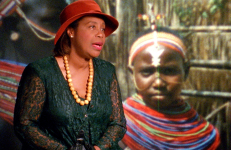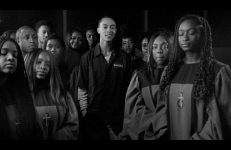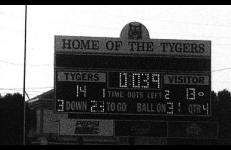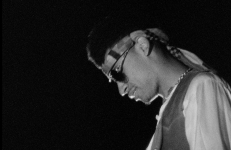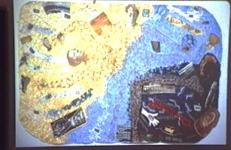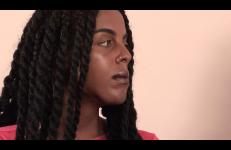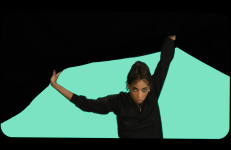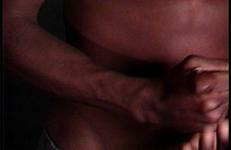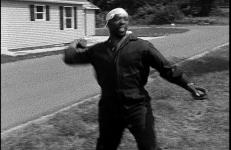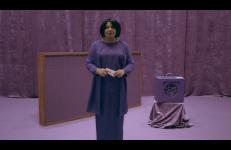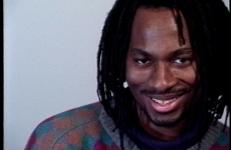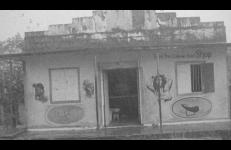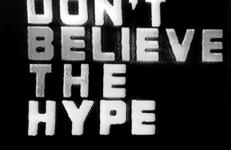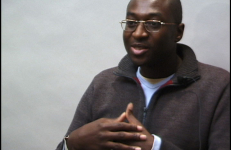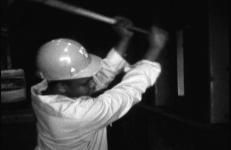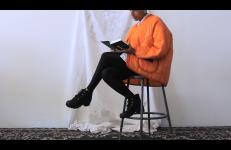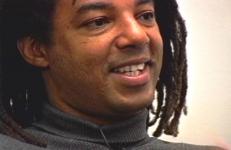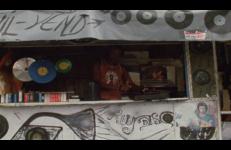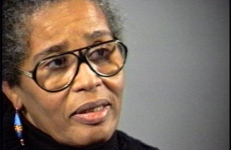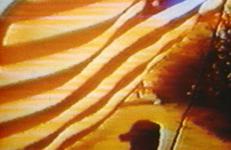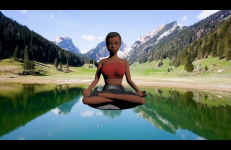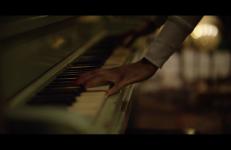A performer lip-synchs to archival audio featuring the voice of author and anthropologist Zora Neale Hurston as she describes her method of documenting African American folk songs in Florida. The flickering images were produced with a hand-cranked Bolex so that the lip-synch is deliberately erratic and the rear-projected, grainy, looped images of Masai tribesmen and women, recycled from an educational film, become increasingly abstract as the audio transforms into an incantation.
African-American
The University of Virginia gospel choir Black Voices returns home from a triumphant concert in Hampton Roads.
This title is only available on Can You Move Like This: Black Fire.
The University of Virginia gospel choir Black Voices returns home from a triumphant concert in Hampton Roads.
This title is only available on Can You Move Like This: Black Fire.
Home is about disappointment in northern Ohio. The scoreboard depicted is on the grounds of Mansfield Senior High. The sentiment conjures the close call.
This title is only available on Broad Daylight and Other Times: Selected Works of Kevin Jerome Everson.
A Sly and the Family Stone tarmac arrival as a point of departure.
This title is only available on Can You Move Like This: Black Fire.
A Sly and the Family Stone tarmac arrival as a point of departure.
This title is only available on Can You Move Like This: Black Fire.
Taped shortly after the creation of the Air Gallery, this conversation between painter Howardena Pindell and Hermine Freed concerns the women’s independent gallery and its role in the feminist movement. Pindell also discusses the development of her work and the relation between black artists and the art world.
Juliana Huxtable was born in Texas and studied at Bard College, NY. An artist working across video, photography, poetry, and music, her practice demands a reexamination of the canon of art history in order to break the cycle of misrepresentation and under-representation in the contemporary art world.
In i am wise enough to die things go (2023), Syms explores the idea of psychosis through an unnamed protagonist reciting a monologue. Responding to the work of iconic animator Chuck Jones, Syms transfers the form and narrative structure of an animated short into live-action. Working with the inherent challenges and restrictions brought about by this sort of translation, she delves into both the breaking up of images and the breakdown of the psyche.
A formidable collage of striking images, this powerful and provocative work confronts racial violence through images of ecological mayhem, machismo, pornography, and Third World poverty — images which return to the taboo body of a black man. "Directed and produced by our culture," An I for An I studies how violence is internalized and psychologized by overlapping soundtracks, printed texts, recurrent images, doctored footage and split screens. The piece attacks racist culture and pleads for an alternative recourse to violence.
Ike is about a person showing their special gift — if pushed. The truth, fiction and lore of a brick thrower with deadly accurate aim.
Cast: Deondre “Champ” Jones, Derron Everson, Anthony Jerrell Jones.
This title is only available on Broad Daylight and Other Times: Selected Works of Kevin Jerome Everson.
Incense Sweaters & Ice is a new feature film inspired by the idea that anything one does while being watched is a performance. The film follows three protagonists — Mrs. Queen Esther Bernetta White, Girl, and WB (“whiteboy”) — as they navigate the dramas of surveillance, moving between looking, being looked at, and remaining unseen. How does the ever-present potential image affect the way we act and the way we see ourselves? By examining how cinema now happens in real time, Syms works between the documented and the live to find the lie.
In this 1993 contribution to the On Art and Artists series, artist Art Jones describes his entry into the world of activist media, and the genesis of his belief in the potential for a democratized street-level media. Hailing from the Bronx, Jones recalls his personal dislocation during college, when he began studying film and video at SUNY Purchase. At that time, Jones experienced a cultural isolation, which he mobilized to fuel his practice. This willingness to confront issues of representation and absence, asserting the validity of his own subjecthood, would become a defining characteristic of his work.
Through distorted audio and visual representations of interviews with music journalists, this video critiques the mass media’s treatment of the rap group Public Enemy, and accusations that their lyrics are anti-Semitic. This experimental documentary includes scenes from Public Enemy performances and music videos, as well as archival footage of the Black Power movement and Malcolm X. Know Your Enemy details the war being waged by black artists on the battleground of representation, a struggle against forms of expression which are already co-opted.
British-Ghanaian, writer, theorist and filmmaker Kodwo Eshun (b.1967) is known for his interest in the electronic mythology of sound. In this interview, Eshun discusses his desire to challenge the predominance of sociological inquiries into the historical and stylistic development of music. Eshun seeks to establish a model of inquiry that is much more concerned with the materiality of sound.
Lead is a tale of an early 20th Century Robin Hood, based on a story by James Williams, involving jumping trains and throwing coal off for needy Southerners.
Cast: Chris Barkley, Hassen Mahamud, Kenny West, James Williams. Cinematography: Jonathan Taee. Sound: Ayesha Ninan.
This title is only available on Broad Daylight and Other Times: Selected Works of Kevin Jerome Everson.
Sections 1-30 of an incomplete extended poem describing the artist's connection to the radical black tradition. The completed poem will be formed of 180 sections.
"Lessons are all about constraints; they are thirty seconds, must feature a black figure, and I have rules about where to make cuts, how to edit sound, etc."
— Martine Syms in conversation with Aram Moshayedi, Mousse Magazine
Sections 31-60 of an incomplete extended poem describing the artist's connection to the radical black tradition. The completed poem will be formed of 180 sections.
"Lessons are all about constraints; they are thirty seconds, must feature a black figure, and I have rules about where to make cuts, how to edit sound, etc."
— Martine Syms in conversation with Aram Moshayedi, Mousse Magazine
Awarded a MacArthur “Genius” Fellowship in 2014, Rick Lowe is a leading practitioner of social practice art. His Row Houses project is a highly lauded example of relational aesthetics successfully deployed. This interview focuses particularly on that work and the artist’s entrance into social practice.
The Diaspora Suite
Filmed on location in Salvador, Brazil (the last city in the Western Hemisphere to outlaw slavery) and Harlem, NY ( an international stronghold of the African Diaspora), Many Thousands Gone draws parallels between a summer afternoon on the streets of the two cities. A silent version of the film was given to jazz multi-instrumentalist Joe McPhee to use an interpretive score. The final film is the combination of the images and McPhee’s real time “sight reading” of the score.
In this 1996 interview, African-American sculptor, printmaker and designer Valerie Maynard (b.1937) describes growing up in Harlem in the mid-20th Century and her awareness of the importance of community during her upbringing. Recalling the prominence of the Baptist church in her early life, Maynard discusses how religion brought her into contact with local politicians who impressed upon her the importance of affecting change. The artist notes how an early affiliation with Congressman Adam Clayton Powell and her brother’s incarceration propelled her interest in social justice and the workings of the judicial system.
An experimental documentary that asks “What is Hip Hop?” Media Assassin deals with popular magazine coverage of the black music scene and efforts to define the new musical forms emerging since the late 80s. The tape focuses on the story of Harry Allen, a former music journalist for The Village Voice, who handled public relations for the rap group, Public Enemy.
Meditation is from Martine Syms’ Kita’s World series. Kita enacts the performances of everyday life in a hyper-digitized world. The character’s roles range from meditation guru to cultural commentator, and she speaks directly to questions of consciousness within the systems of labor, race, technology, and institutional failure. To the cognitive dissonance of Siri mishearing her speech, to the terror of (mis)representation, to the instinct to reconnect with nature.
Memory Palace is a short video grounded in the personal history of the artist. A discovery of a photo album activates memories of physical spaces, which in turn open doors to reminiscences of past family life. Inspired by the classical method of loci, the film presents a woman — singer/songwriter Alice Smith — at work in Los Angeles.




